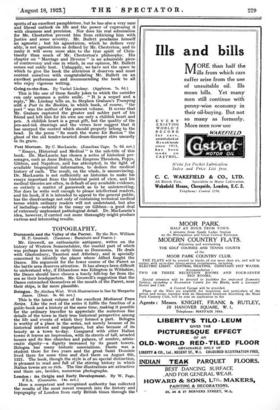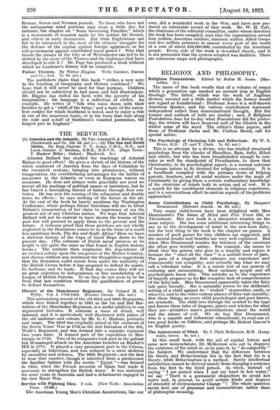TOPOGRAPHY.
Dumnonia and the Valley of the Parret. By the Bay. William H. P. Greswell. (Taunton : Bamicott and Pearce.)
Mr. Greswell, an enthusiastic antiquary, writes on the history of Western Somersetshire, the coastal part of which was perhaps known in early times as Dumnonia. He deals with Glastonbury, Taunton and Athelney, and is specially concerned to identify the places where Alfred fought the Danes. His argument for the lower course of the I'arret as the battle area deserves attention. It has always been difficult to understand why, if Ethandune was Edington in Withshire, the Danes should have chosen a lonely hill-top far from the sea as their headquarters. Mr. Greswell's suggestion that the Danes entrenched themselves at the mouth of the Parret, near their ships, is far more plausible.
Bologna. By Alethea Wiel. With illustrations in line by Margarita Janes. (Dent. be. 6d. net.) This is the latest volume of the excellent Mediaeval Town Series. Like the rest of the series it fulfils the function of a guide-book and a history at the same time, making it possible for the ordinary traveller to appreciate the numerous fine details of the town in their true historical perspective among the life and events of which they formed a part. Bologna is worthy of a place in the series, not merely because of its historical interest and importance, but also because of its beauty as a town to-day. Compared with other Italian towns it leaves an impression, with its streets of tall, arcaded houses and its fine churches and palaces, of sombre, aristocratic dignity—a dignity increased by its gaunt towers. Bologna has many historic associations. Dante was a student there for two years and the great Saint Dominic lived there for some time and died there on August 6th, 1221. The book, though the style is of no special distinction, is pleasant to read and full of the stirring history in which Italian towns are so rich. The line illustrations are attractive and there are, besides, numerous photographs.
London : its Origin and Early Development. By W. Page, F.S.A. (Constable. 14s. net.)
Here a competent and recognized authority has collected the results of the most recent research into the history and topography of London from early British times through the Roman, Saxon and Norman periods. To those who have not the antiquarian mind portions may seem a little dry, for instance, the chapter on " Some Governing Families," which is a monument of research made by the author. Dr. Round, and others in early documents. But what Englishman can fail to be interested in the story of the citizens' struggles for the defence of the capital against foreign aggressors or for self-government against established royal power ? Who that treads the streets of the City or of Westminster can fail to be stirred by the story of the Thames and the highways that have developed beside it ? Mr. Page has produced a book without which no Londoner's library will be complete.
Father Thames. By Walter Higgins. Wells Gardner, Dorton and Co., Ltd. 7s. 6d. net.) The publishers claim that this book " strikes a new mote in the teaching of Geography and History combined." We hope that it will never be used for that purpose. Children should not be submitted to bad prose and bad illustrations. Mr. Higgins has dulled his facts with the poverty of his imagination • his language is a collection of cliches. An example. He writes of folk who come down with their families to get a ' whiff of the briny,' and a taste of the succulent cockles for which Southend is noted, and to enjoy a ride in one of the numerous boats, or in the tram that runs along the mile and a-half of 'Southend's vaunted possession, the longest pier in England."



































 Previous page
Previous page